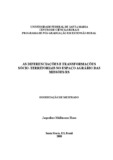| dc.creator | Haas, Jaqueline Mallmann | |
| dc.date.accessioned | 2009-03-25 | |
| dc.date.available | 2009-03-25 | |
| dc.date.issued | 2008-12-19 | |
| dc.identifier.citation | HAAS, Jaqueline Mallmann. The social-territorial differenciation and transformation in the agrarian space in Missões/RS. 2008. 163 f. Dissertação (Mestrado em Agronomia) - Universidade Federal de Santa Maria, Santa Maria, 2008. | por |
| dc.identifier.uri | http://repositorio.ufsm.br/handle/1/8835 | |
| dc.description.abstract | This research aims to investigate the dynamic and the process of differenciation that happened
in the agrarian space of the Developmental Regional Council Missões. The region of study
is located in the northwest of Rio Grande do Sul State and it is caracterized specially by its
eminently agricultural features and the predominance of the familiar agriculture.
Methodologically, we used the method of study/analysis of agrarian spaces (territory). It is
known as Agrarian Systems Diagnostic Analysis and we also applied the multivariated
analysis to complement this research. This research identified two differents agrarian systems
historically constructed in the study´s space and the conformation of diferents homogeneous
zones based on the criteria of analysis. Using criteria of natural conditions of the environment,
it was possible to identify four homogeneous zones. On the other hand, when considering
socioeconomical aspects, we identified five homogenous zones. In relation to the
differentiation between agriculturists, we established a typology of rural establishment. In this
context, we identified categories such as retired, miniagrarian, familiars and employer. In
relation to the types of systems of production practiced by the agriculturist, we identified
between the employer establishments the predonimant dynamic that is specialized in the grain
cultures. The cattle culture have been losing space and importance in those establishments. In
the familiar establishment, the milk-cattle culture is the main activity prepoderant. We also
can identified that in the system area of agrarian field, it is predominant the employer
agriculture. In this context, we have homegenous zones where the cattles still expressive and
other in which the specialization of grain activities is dominant. Yet, in the agrarian system
there is predonimance of familiar agriculture and small establishments. Generally, even
though the non-linear transformation and the different ways of the homogenous zones
identified, we expect that, in a medium time, the study area will present a diversified
productive matrix. Futhermore, we believe that those results will not reflect in the production
units that are following the inverse way, because they will probably become extremely
specialized. | eng |
| dc.description.sponsorship | Coordenação de Aperfeiçoamento de Pessoal de Nível Superior | |
| dc.format | application/pdf | por |
| dc.language | por | por |
| dc.publisher | Universidade Federal de Santa Maria | por |
| dc.rights | Acesso Aberto | por |
| dc.subject | Diferenciação | por |
| dc.subject | Transformação | por |
| dc.subject | Espaço agrário | por |
| dc.subject | COREDE-Missões | por |
| dc.subject | Differentiation | eng |
| dc.subject | Transformation | eng |
| dc.subject | Agrarian space | eng |
| dc.subject | COREDE-Missões | eng |
| dc.title | As diferenciações e transformações sócio-territoriais no espaço agrário das Missões/RS | por |
| dc.title.alternative | The social-territorial differenciation and transformation in the agrarian space in Missões/RS | eng |
| dc.type | Dissertação | por |
| dc.description.resumo | O presente estudo tem por objetivo investigar a dinâmica e o processo de diferenciação ocorrido no espaço agrário de abrangência do Conselho Regional de Desenvolvimento
Missões. A região em estudo localiza-se ao noroeste do estado do Rio Grande do Sul e caracteriza-se especialmente por seu caráter eminentemente agrícola e a predominância da
agricultura familiar. Como procedimento metodológico geral, utiliza-se do método de estudo/análise de espaços agrários, conhecido como Análise Diagnóstico de Sistemas
Agrários, e de modo complementar, emprega-se a Análise Multivariada. A pesquisa identificou dois distintos sistemas agrários historicamente constituídos no espaço de estudo e
a conformação de diferentes zonas homogêneas, conforme critérios de análise. Utilizando critérios de condições naturais do meio, foi possível a identificação de quatro zonas
homogêneas, já quando levado em consideração os aspectos socioeconômicos são identificadas cinco zonas homogêneas. Em relação à diferenciação entre agricultores, estabelecesse inicialmente uma tipologia dos estabelecimentos rurais, sendo identificadas principalmente as categorias de aposentados, minifundiários, familiares e patronais. Quanto aos tipos de sistemas de produção praticados pelos agricultores, identifica-se que entre os estabelecimentos patronais a dinâmica predominante é de especialização nas culturas de
grãos, sendo que a pecuária de corte vem perdendo seu espaço e importância nestes estabelecimentos, já nos estabelecimentos familiares a pecuária de leite é a atividade
preponderante. Identifica-se ainda que na área do sistema agrário de campo, há predominância da agricultura patronal, tendo uma zona onde a pecuária de corte ainda é expressiva e outra onde a especialização nas atividades de grãos é preponderante, e na área do sistema agrário de mata a predominância de agricultores familiares e pequenos estabelecimentos. De modo geral, apesar das transformações não lineares e as diferentes trajetórias das zonas homogêneas
identificadas, as perspectivas são de que a região em estudo, em médio prazo, venha a apresentar uma matriz produtiva diversificada, o que possivelmente não se refletirá nas
unidades de produção, que se apresentam no caminho inverso, ou seja, tendem a se tornarem altamente especializadas. | por |
| dc.contributor.advisor1 | Neumann, Pedro Selvino | |
| dc.contributor.advisor1Lattes | http://lattes.cnpq.br/0786069109358002 | por |
| dc.contributor.referee1 | Silva Neto, Benedito | |
| dc.contributor.referee1Lattes | http://lattes.cnpq.br/7824212615529253 | por |
| dc.contributor.referee2 | Fialho, Marco Antônio Verardi | |
| dc.contributor.referee2Lattes | http://lattes.cnpq.br/7125745710337738 | por |
| dc.creator.Lattes | http://lattes.cnpq.br/1317914904195158 | por |
| dc.publisher.country | BR | por |
| dc.publisher.department | Agronomia | por |
| dc.publisher.initials | UFSM | por |
| dc.publisher.program | Programa de Pós-Graduação em Extensão Rural | por |
| dc.subject.cnpq | CNPQ::CIENCIAS AGRARIAS::AGRONOMIA | por |


